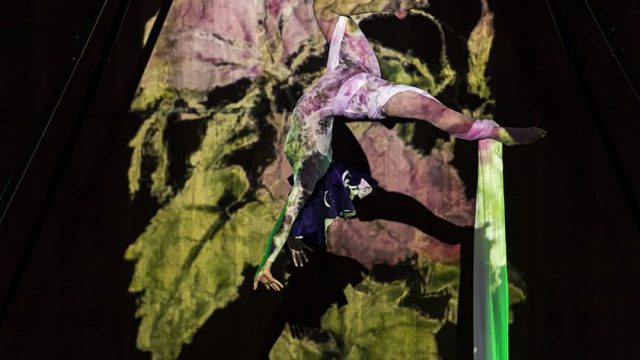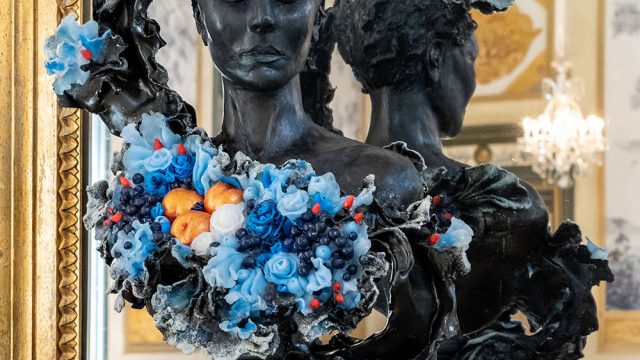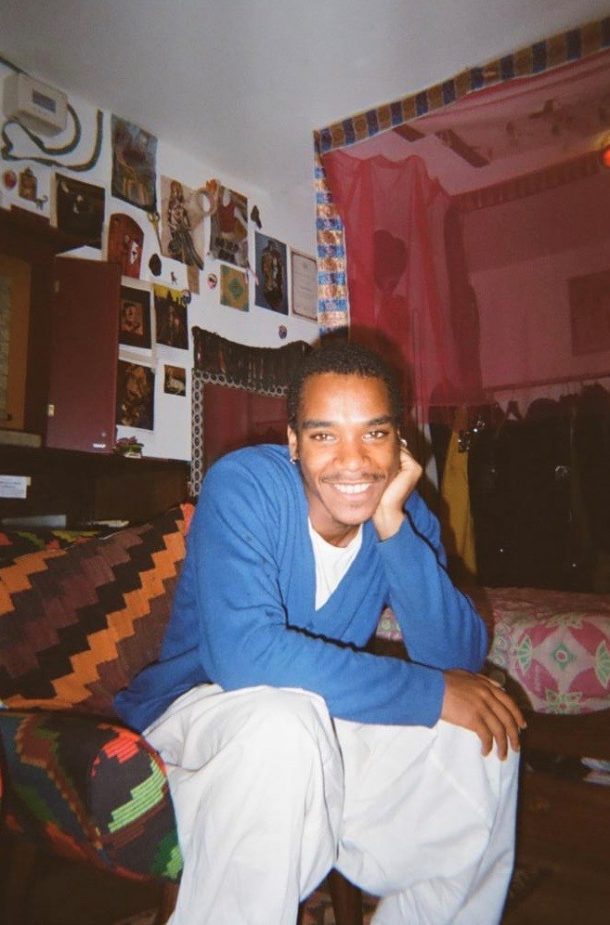
This conversation between Moses Quiquine and Susanna Brown, V&A Curator of Photographs, took place in November 2020 – at the end of Moses’ Residency.
You began your V&A residency in October 2019. Did you already know the museum well when you arrived?
Moses When I was little, I loved the Natural History Museum across the road from the V&A – the dinosaurs, birds and the history of the natural world, but as I grew up, I became more curious about the V&A. The V&A is about human skill and human invention. Everything in the V&A has been crafted by people, and I really wanted to engage with human ingenuity.
I got to know the permanent fashion collection pretty well, and was always interested in the hand-crafted elements of garments – embellishments and beadwork from the Medieval period all the way to the contemporary. Clothing is layered with symbolism. There’s one V&A dress that stood out to me in the collection, worn by Queen Elizabeth II on a state visit to France in 1957. It has embroidered miniature bees, grasses, wheat and wildflowers and refers to French motifs, such as the emblem of Napoleon. Royal clothing often holds a lot of symbolic weight. Garments can be a way of recording and representing a culture or a wearer at a particular moment in time.
My mum, Chantal, owns a vintage couture archive that has always influenced my work and my approach to making. From 2017 to 2018, I shadowed the costume designer Denis Bruno for a year and learnt about tailoring and delicate handwork.
The resident artists and designers have access to the whole V&A collection and the hundreds of experts who care for the objects. How did you initially navigate this massive collection?
When I first joined the museum, I had a two-week induction visiting the many V&A collection stores at Blythe House, in West Kensington, the Museum of Childhood and even going to Stratford to see the spaces where V&A East will be built. It was a great, but overwhelming, experience and I wanted to engage with everything. The curators around the museum were always happy to share their knowledge and expertise. The title of my residency was ‘Sourcing Beauty’, and it was challenging to know where to start. I wasn’t looking for something tangible, but I was searching for something that touched on my own sensibilities and that spoke to me. I loved being in the museum until late in the evenings and I would walk around the galleries on my own.
To source the beauty, for me, was to engage with the museum from a new perspective, I wasn’t a visitor anymore and I started to feel ‘at home’ in the museum.
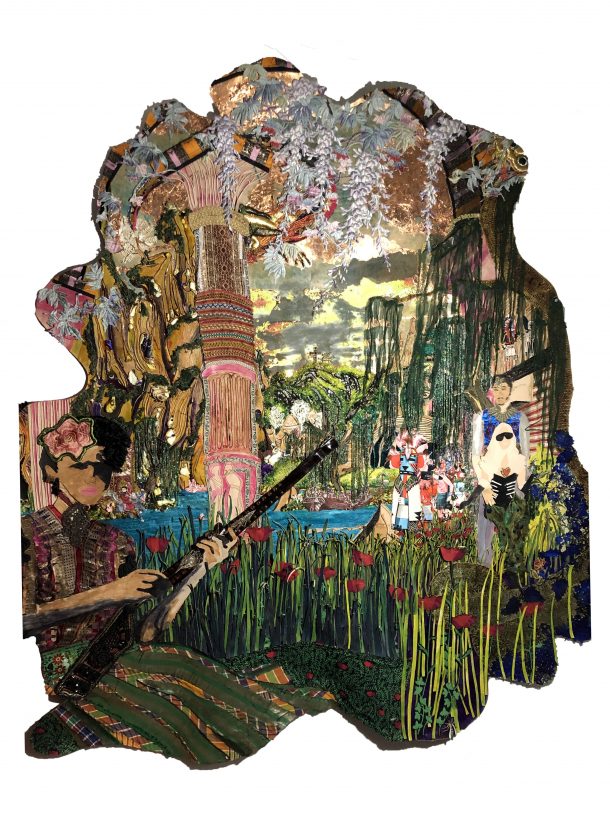
Can you tell us about Gabrielle, your final residency piece?
The piece reflects the dialogues between the disparate objects I encountered in the museum. Every object in the V&A has a unique history and is connected to different traditions, regions, religions and cultures, but they are also connected to each other – because they are all cared for by one museum.
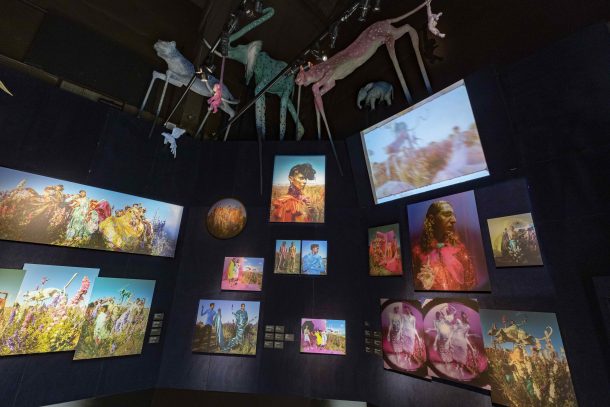
Your final piece is also inspired by the exhibition Tim Walker: Wonderful Things (21 September 2019 – 22 March 2020), which I curated. Can we talk more about that connection?
In the exhibition, there was a photoshoot titled Cloud 9 which was partly inspired by two Indian miniature paintings in the South Asia collection of the V&A. This section of the exhibition really stood out to me as I loved the vibrant colours in the room, and the dynamic pictures Tim created. This prompted me to research my own ancestry, as I’d recently found out that my grandmother from my mother’s side came from South Asia to the Caribbean in the early twentieth century. I was born in Britain and grew up in London, but I’m of French Caribbean descent. As I got older, I wanted to engage with my ancestry on a deeper level and embellish myself with my ancestry and wear it proudly. The Caribbean has Creole roots, which refer to a mixture of cultures and the mixed-race descendants of Europeans, Africans and Asians, who were born or lived in the islands. Workers from Asian countries such as India and China went to the Caribbean around the mid-nineteenth century. The Creole people formed a common culture based on their experiences of living together in countries colonised by France, Spain, the UK and the Netherlands. As a result, a Creole person from the Caribbean could have European ancestry, as well as ancestry from Africa or Asia.
The woman holding a shotgun in the bottom left corner of my piece is my grandmother, who has Indian heritage. I have an amazing photograph of her on a hunting weekend, she’s wearing a white gown and holding a huge shotgun. Hunting was a pastime pursued by a certain layer of society, quite privileged people. I don’t think she realised this at the time, but when I look at the photo it’s clear that she was mixing cultures and aspiring to become someone of a higher status. By holding this gun, she was saying ‘I’m going to be more than just what my culture says’. I’ve depicted her as hunting a silver deer.
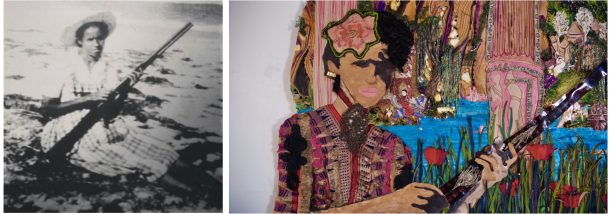
Your work is so rich and so layered. I’d love to know more about the symbolism of the other details and motifs?
The canyon area of the piece was inspired by the Indian miniature paintings displayed in Tim Walker: Wonderful Things. I wanted the viewer to feel immersed in this world, so I’ve made them much taller than they appear in the small paintings. There are poppies in the foreground – which in the UK, are of course linked to war and remembrance. Conflict and disagreement are always present for me and I felt I couldn’t leave this out of my piece. The photographs that Tim took for Cloud 9 showed flowers in a field in Worcestershire, which are grown to make wedding confetti. I liked the contrast between these delicate beautiful things, and weight of their symbolism. The Indian miniature paintings showed battle scenes too – but were still incredibly beautiful and detailed.
The pink pillars in the piece are inspired by the view from my studio window at the V&A. The studio was in the Henry Cole Wing of the museum, which overlooks Exhibition Road. It’s a red building, with beautiful arches and pillars, designed by architect Henry Scott (1822 – 1883) in the 1870s. I could never get used to this view and it always felt like a special reminder of where I was. I had to find a way to bring this into the final piece and made the pillars pink. The piece has a lot of pink elements and I’ve surrounded myself with this colour recently. Now even my bedroom walls are pink.
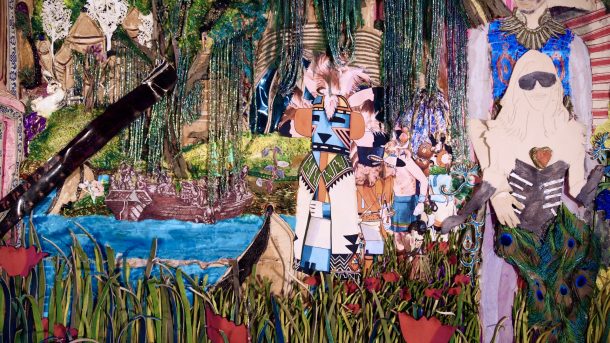
The cartoonish pink and blue figures are from a cut off piece from a Hermès scarf scrap designed by American artist Kermit Oliver (b.1943). I think he’s one of the only black artists whose work Hermès has shown on their scarves. He often depicts Native Americans and, to me, these figures are almost like alien versions of the Native Americans. I wanted to make all of these figures co-habit within my piece and in the world I created. They sit alongside a little plastic doll of a black girl. I wanted to mix materials to suggest a mixing of cultures, and to link back to my own roots. You can have blue or pink skin, you can be made of silk or made of plastic, and still be part of one family. I also included a cutting from a Toile de Jouy from the 1920s. It depicts a battle scene at sea with small ships and big ships. I love the character who is in the water who looks like he’s fallen out and has been left stranded in the stream. And characters that appear to be from the future stand on the land just behind the boat.
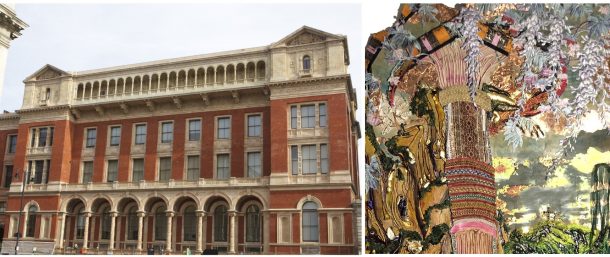
Can you tell us more about your approach to materials?
The backing of the piece is vegetable tanned (veg tan) leather, which is leather that can be dyed or moulded into different shapes. I can add dimension to the leather by cutting into it and embroidering it, adding layers. It has become one of my go-to materials. I love that I can change it easily if I change my mind about something in the work by patching over it or dyeing it.
The glass beading used for the willow trees came from a 1920s flapper dress. I dyed the beading an emerald green and turned it into leaves. In the same way that something historical can appear next to something contemporary at the V&A, I wanted to blend together the different strands of time and sources in my final piece. It’s a mixture of textiles and culture, which relates back to my mixed heritage too.
I listened to a programme on a philosopher from Martinique called Édouard Glissant (1928 – 2011) and he discussed the idea of seeking utopia. For Glissant, utopia is the things that we are seeking. He says, in an interview with Lise Gauvin, it is ‘the accumulation, without exception, of all the beauties, all the adversities, and all the values of the world’. In a way, I think I have constantly engaged with this as I was questioning what I was seeking. It became an organic thing where different materials came into dialogue with each other.
How did you find the interaction with V&A visitors and opening your studio to them?
It was a gift. I love people and I was very grateful to engage with so many V&A visitors from all walks of life. There is something for everyone to engage with at the museum. A team of V&A volunteers would facilitate the open studios and they were amazing. Before the visitors arrived, we had a conversation about my work and as soon the visitors came in, the volunteers were sharing my work with them and explaining everything. It was great as I could tell they were excited about my work and were encouraging visitors to be excited too.
What’s next for you?
Since the end of my residency, I have started to think about merchandising and making clothing that can reach wider audiences. This year, I will be in conversation with Christine Checinska, Curator of African and African Diaspora Fashion at the V&A, at the Yale Center for British Art. My work also featured in an exhibition in February 2021 in Milan and a show at the Crafts Council in Spring in London. A lot of things are happening, and my residency has definitely been a catalyst for me to make more work and to engage with a wider audience. I’m very grateful for that.
@MosesQuiquine
Watch our video about Moses’ residency:
https://youtu.be/LXwWzJIHjjA

